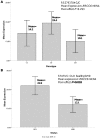The ERCC6 gene and age-related macular degeneration
- PMID: 21072178
- PMCID: PMC2967476
- DOI: 10.1371/journal.pone.0013786
The ERCC6 gene and age-related macular degeneration
Abstract
Background: Age-related macular degeneration (AMD) is the leading cause of irreversible visual loss in the developed countries and is caused by both environmental and genetic factors. A recent study (Tuo et al., PNAS) reported an association between AMD and a single nucleotide polymorphism (SNP) (rs3793784) in the ERCC6 (NM_000124) gene. The risk allele also increased ERCC6 expression. ERCC6 is involved in DNA repair and mutations in ERCC6 cause Cockayne syndrome (CS). Amongst others, photosensitivity and pigmentary retinopathy are hallmarks of CS.
Methodology/principal findings: Separate and combined data from three large AMD case-control studies and a prospective population-based study (The Rotterdam Study) were used to analyse the genetic association between ERCC6 and AMD (2682 AMD cases and 3152 controls). We also measured ERCC6 mRNA levels in retinal pigment epithelium (RPE) cells of healthy and early AMD affected human donor eyes. Rs3793784 conferred a small increase in risk for late AMD in the Dutch population (The Rotterdam and AMRO-NL study), but this was not replicated in two non-European studies (AREDS, Columbia University). In addition, the AMRO-NL study revealed no significant association for 9 other variants spanning ERCC6. Finally, we determined that ERCC6 expression in the human RPE did not depend on rs3793784 genotype, but, interestingly, on AMD status: Early AMD-affected donor eyes had a 50% lower ERCC6 expression than healthy donor eyes (P = 0.018).
Conclusions/significance: Our meta-analysis of four Caucasian cohorts does not replicate the reported association between SNPs in ERCC6 and AMD. Nevertheless, our findings on ERCC6 expression in the RPE suggest that ERCC6 may be functionally involved in AMD. Combining our data with those of the literature, we hypothesize that the AMD-related reduced transcriptional activity of ERCC6 may be caused by diverse, small and heterogeneous genetic and/or environmental determinants.
Conflict of interest statement
Figures


References
-
- Friedman DS, O'Colmain BJ, Munoz B, Tomany SC, McCarty C, et al. Prevalence of age-related macular degeneration in the United States. Arch Ophthalmol. 2004;122:564–572. - PubMed
-
- Vingerling JR, Dielemans I, Hofman A, Grobbee DE, Hijmering M, et al. The prevalence of age-related maculopathy in the Rotterdam Study. Ophthalmology. 1995;102:205–210. - PubMed
-
- Klaver CC, Wolfs RC, Assink JJ, van Duijn CM, Hofman A, et al. Genetic risk of age-related maculopathy. Population-based familial aggregation study. Arch Ophthalmol. 1998;116:1646–1651. - PubMed
-
- Seddon JM, Cote J, Page WF, Aggen SH, Neale MC. The US twin study of age-related macular degeneration: relative roles of genetic and environmental influences. Arch Ophthalmol. 2005;123:321–327. - PubMed
-
- Edwards AO, Ritter R, III, Abel KJ, Manning A, Panhuysen C, et al. Complement factor H polymorphism and age-related macular degeneration. Science. 2005;308:421–424. - PubMed
Publication types
MeSH terms
Substances
Grants and funding
LinkOut - more resources
Full Text Sources
Medical

